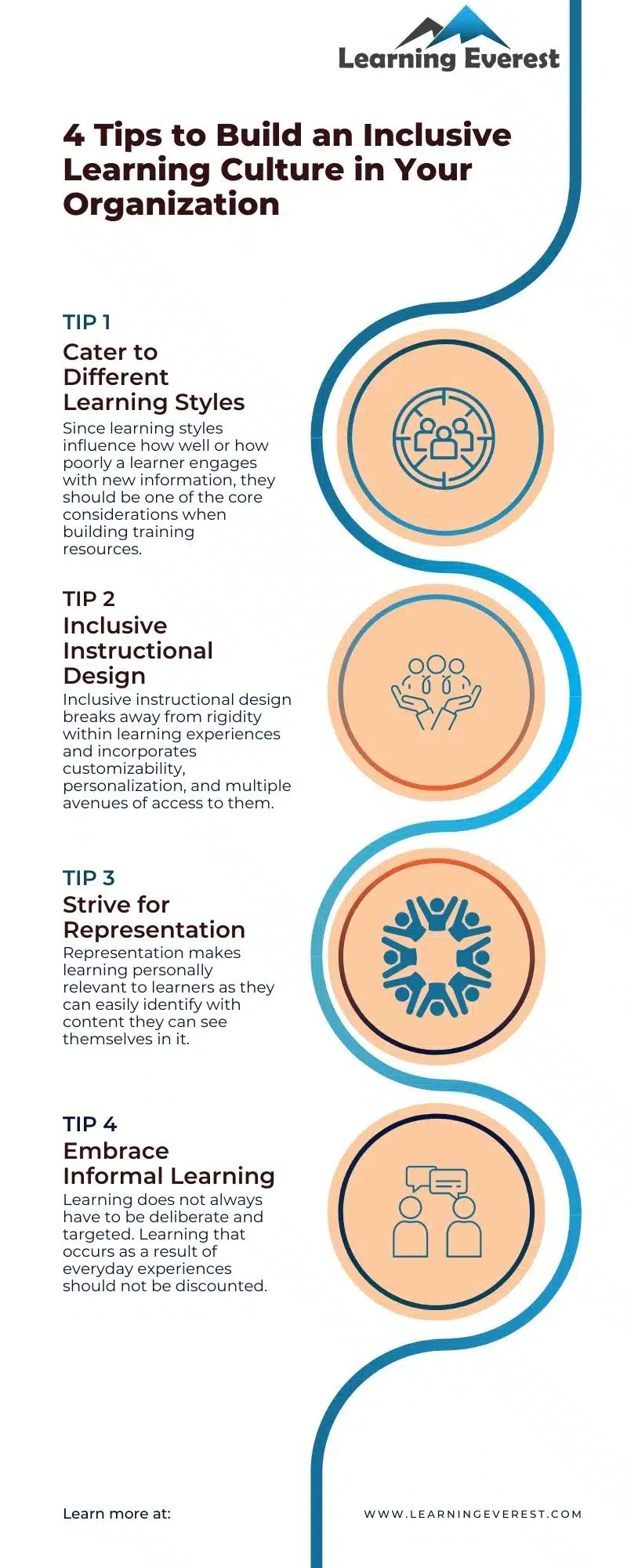In the L&D sphere, there’s always talk of learning cultures but very little mention of an inclusive learning culture. Whether organizations deliberately pursue diversity or not, they are inherently diverse to some extent because due to individual differences among employees. Building a culture of learning is, therefore, better than one that isn’t, because it has a broader scope within the company. In this article, you will find 4 tips for fostering a diverse learning culture in your organization so that all employees can participate equally.
Tip 1 – Cater to different learning styles
Each individual has a unique mix of learning styles that work best for them. Some might learn by watching and following a tutorial, some by reading and solving questions and problems, and for others learning might be most effective when done with other people. Since learning styles influence how well or how poorly a learner engages with new information, they should be one of the core considerations when building training resources. Additionally, learners with disabilities, chronic conditions, and permanent or temporary impairments will often have unique requirements for learning.
Some ways to make learning more relevant for different kinds of learners are:
- Presenting all information in more than one form. For example, a concept can be represented using a picture, a text description, and a voiceover so that learners get a multimodal experience.
- Providing case studies, scenarios, and simulations for learners who learn best by doing
- Developing resources of different types for each training module, if feasible, and giving learners the option to complete the training in the format they are most comfortable with
Tip 2 – Inclusive instructional design
Inclusive instructional design is the practice of creating learning experiences that cater to cultural differences as well as differences in ability.
Inclusive instructional design breaks away from rigidity within learning experiences and incorporates customizability, personalization, and multiple avenues of access to them. This type of instructional design requires companies to thoroughly evaluate their learners’ needs and the pitfalls of the current curriculum.
One of the most important factors for nurturing an inclusive learning culture through inclusive instructional design is to take continuous feedback from learners. Feedback helps organizations identify barriers they need to tackle.
To offer feedback and suggestions openly, it is essential that employees know that there is a safe space in the organization for doing so. Some strategies to routinely collect feedback are:
- Set up a community suggestion box or forum
- Specify that suggestions regarding inclusive learning are welcome
- Give learners the option of anonymity when giving feedback
- Conduct regular surveys to gauge learner reception of training initiatives
Hire diversity and inclusivity experts for guidance
- Train managers and executives to build empathy and develop an eye for potentially alienating practices
Tip 3 – Strive for representation
Representation makes learning personally relevant to learners as they can easily identify with content they can see themselves in it. If your goal is to build an inclusive learning culture in your organization, it’s imperative that learning materials reflect your learners.
When developing learning materials, keep the following tips in mind:
- Personalize courses by letting learners use their names and pick avatars before beginning a module
- When creating characters for your course, give them traits that the learners can relate to. Be sure to make these characters diverse in terms of gender, age, race, sexual orientation, physical abilities, etc.
Tip 4 – Embrace informal learning
Lastly, embrace informal learning opportunities. An inclusive learning culture is not just about formal learning opportunities. An organizational learning culture is a shared mindset that permeates all departments of a business. Thus, there is no reason why an inclusive organizational learning culture will be any different.
Learning does not always have to be deliberate and targeted. For some, an excess of such kind of learning might even be a barrier. It is normal for employees to experience fatigue if they constantly learn through e-learning courses and webinars. This is especially true for people who have special needs, be it in terms of access or their training requirements.
For this reason, learning that occurs as a result of interaction and information sharing among peers, mentor-mentee groups, and everyday experiences should not be discounted.
Businesses should encourage employees to share their knowledge with each other so that the entire organization can reap its benefits. This can also promote a culture of spontaneous mentoring and collaboration among employees, creating a continuous flow of useful information among members. The post of SHRM can also provide you with good insights.
Infographics

4 Tips to Build an Inclusive Learning Culture in Your Organization
Conclusion
An inclusive learning culture might sound like a challenge at first, but there is no harm in starting small. By leveraging e-learning resources, employee feedback, and community involvement, businesses can start making a shift towards greater inclusivity in how and what their employees learn. An inclusive learning culture will also attract more diverse talent and uplift potentially marginalized employees.





